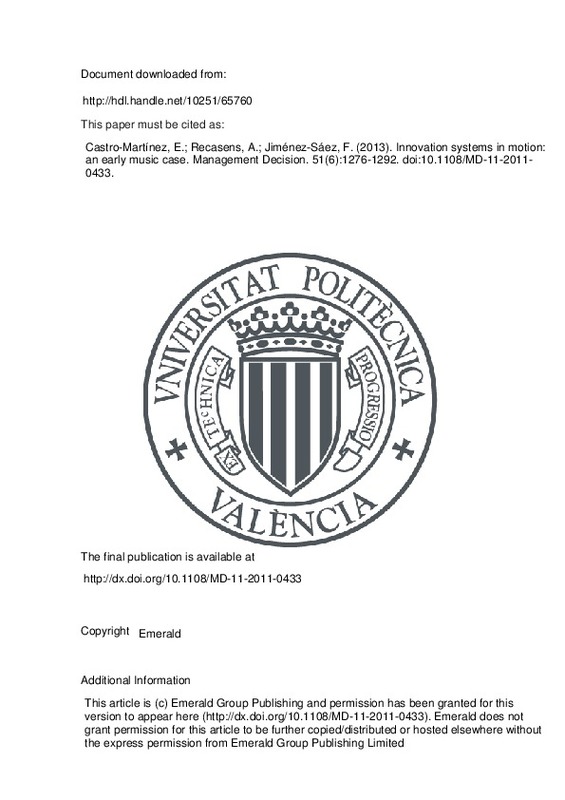Amable, B., & Palombarini, S. (1998). Technical change and incorporated R&D in the service sector. Research Policy, 27(7), 655-675. doi:10.1016/s0048-7333(98)00076-6
Asheim, B., Coenen, L., Moodysson, J., & Vang, J. (2007). Constructing knowledge-based regional advantage: implications for regional innovation policy. International Journal of Entrepreneurship and Innovation Management, 7(2/3/4/5), 140. doi:10.1504/ijeim.2007.012879
Asheim, B., & Hansen, H. K. (2009). Knowledge Bases, Talents, and Contexts: On the Usefulness of the Creative Class Approach in Sweden. Economic Geography, 85(4), 425-442. doi:10.1111/j.1944-8287.2009.01051.x
[+]
Amable, B., & Palombarini, S. (1998). Technical change and incorporated R&D in the service sector. Research Policy, 27(7), 655-675. doi:10.1016/s0048-7333(98)00076-6
Asheim, B., Coenen, L., Moodysson, J., & Vang, J. (2007). Constructing knowledge-based regional advantage: implications for regional innovation policy. International Journal of Entrepreneurship and Innovation Management, 7(2/3/4/5), 140. doi:10.1504/ijeim.2007.012879
Asheim, B., & Hansen, H. K. (2009). Knowledge Bases, Talents, and Contexts: On the Usefulness of the Creative Class Approach in Sweden. Economic Geography, 85(4), 425-442. doi:10.1111/j.1944-8287.2009.01051.x
Castro‐Martínez, E., Fernández de Lucio, I., Pérez‐Marín, M. and Criado‐Boado, F. (2008a), “La transferencia de conocimientos desde las Humanidades: posibilidades y características”,Arbor, Vol. 184 No. 732, pp. 619‐636.
Chapain, C., & Comunian, R. (2009). Enabling and Inhibiting the Creative Economy: The Role of the Local and Regional Dimensions in England. Regional Studies, 44(6), 717-734. doi:10.1080/00343400903107728
Consoli, D. (2005). The dynamics of technological change in UK retail banking services: An evolutionary perspective. Research Policy, 34(4), 461-480. doi:10.1016/j.respol.2005.02.001
Consoli, D., & Mina, A. (2008). An evolutionary perspective on health innovation systems. Journal of Evolutionary Economics, 19(2), 297-319. doi:10.1007/s00191-008-0127-3
Cunningham, S. (2002), “From cultural to creative industries: theory, industry, and policy implications”,Media International Australia Incorporating Culture and Policy: Quarterly Journal of Media Research and Resources, pp. 54‐65, available at: http://eprints.qut.edu.au/588/ (accessed 31 May 2011).
Cunningham, S., Cutler, T., Hearn, G., Ryan, M. and Keane, M. (2004), “An innovation agenda for the creative industries: where is the R&D?”,Media International Australia; Incorporating Culture and Policy, No. 112, pp. 174‐185.
Davis, C. H., Creutzberg, T., & Arthurs, D. (2009). Applying an innovation cluster framework to a creative industry: The case of screen-based media in Ontario. Innovation, 11(2), 201-214. doi:10.5172/impp.11.2.201
Djellal, F., & Gallouj, F. (2005). Mapping innovation dynamics in hospitals. Research Policy, 34(6), 817-835. doi:10.1016/j.respol.2005.04.007
Eltham, B. (2009). Australian cultural and innovation policies: Never the twain shall meet? Innovation, 11(2), 230-239. doi:10.5172/impp.11.2.230
Ettlie, J. E., & Rosenthal, S. R. (2011). Service versus Manufacturing Innovation*. Journal of Product Innovation Management, 28(2), 285-299. doi:10.1111/j.1540-5885.2011.00797.x
Gander, J., & Rieple, A. (2002). Inter-organisational Relationships in the Worldwide Popular Recorded Music Industry. Creativity and Innovation Management, 11(4), 248-254. doi:10.1111/1467-8691.00256
García-Aracil, A., & Fernández De Lucio, I. (2008). Industry–University Interactions in a Peripheral European Region: An Empirical Study of Valencian Firms. Regional Studies, 42(2), 215-227. doi:10.1080/00343400601142704
Hjalager, A. (2009). Cultural Tourism Innovation Systems – The Roskilde Festival. Scandinavian Journal of Hospitality and Tourism, 9(2-3), 266-287. doi:10.1080/15022250903034406
Hirsch, P. M. (2000). Cultural Industries Revisited. Organization Science, 11(3), 356-361. doi:10.1287/orsc.11.3.356.12498
Hotho, S., & Champion, K. (2011). Small businesses in the new creative industries: innovation as a people management challenge. Management Decision, 49(1), 29-54. doi:10.1108/00251741111094428
Jaaniste, L. (2009). Placing the creative sector within innovation: The full gamut. Innovation, 11(2), 215-229. doi:10.5172/impp.11.2.215
Jeffcutt, P., & Pratt, A. C. (2002). Managing Creativity in the Cultural Industries. Creativity and Innovation Management, 11(4), 225-233. doi:10.1111/1467-8691.00254
Jöckel, S., Will, A., & Nawrath, U. (2007). Consumer Preferences towards Commercial Music Downloads. Journal of Media Business Studies, 4(3), 1-19. doi:10.1080/16522354.2007.11073453
Le Blanc, A. (2010), “Cultural districts, a new strategy for regional development?”,The South‐East Cultural District in Sicily, Regional Studies, Vol. 44 No. 7, pp. 905‐917.
Lorenzen, M., & Frederiksen, L. (2005). The management of projects and product experimentation: examples from the music industry. European Management Review, 2(3), 198-211. doi:10.1057/palgrave.emr.1500044
Lundvall, B. (2007). National Innovation Systems—Analytical Concept and Development Tool. Industry & Innovation, 14(1), 95-119. doi:10.1080/13662710601130863
McLean, R., Oliver, P. G., & Wainwright, D. W. (2010). The myths of empowerment through information communication technologies. Management Decision, 48(9), 1365-1377. doi:10.1108/00251741011082116
Malerba, F. (2002). Sectoral systems of innovation and production. Research Policy, 31(2), 247-264. doi:10.1016/s0048-7333(01)00139-1
Miles, I. (2000), “Services innovation: coming of age in the knowledge‐based economy”,International Journal of Innovation Management, Vol. 4 No. 4, pp. 371‐389.
Potts, J. (2009). Introduction. Innovation, 11(2), 138-147. doi:10.5172/impp.11.2.138
Potts, J., Cunningham, S., Hartley, J., & Ormerod, P. (2008). Social network markets: a new definition of the creative industries. Journal of Cultural Economics, 32(3), 167-185. doi:10.1007/s10824-008-9066-y
Power, D., & Hallencreutz, D. (2002). Profiting from Creativity? The Music Industry in Stockholm, Sweden and Kingston, Jamaica. Environment and Planning A: Economy and Space, 34(10), 1833-1854. doi:10.1068/a3529
Pratt, A. C. (2005). Cultural industries and public policy. International Journal of Cultural Policy, 11(1), 31-44. doi:10.1080/10286630500067739
Ramlogan, R. and Consoli, D. (2007), “Knowledge, understanding and the dynamics of medical innovation”,European Journal of Economic and Social Systems, Vol. 20 No. 2, pp. 231‐249.
Sundbo, J. (2009). Innovation in the experience economy: a taxonomy of innovation organisations. The Service Industries Journal, 29(4), 431-455. doi:10.1080/02642060802283139
Sundbo, J., Orfila-Sintes, F., & Sørensen, F. (2007). The innovative behaviour of tourism firms—Comparative studies of Denmark and Spain. Research Policy, 36(1), 88-106. doi:10.1016/j.respol.2006.08.004
Van der Groep, R. (2009). ‘Breaking Out’ and ‘Breaking In’: Changing Firm Strategies in the Dutch Audiovisual Industry. Regional Studies, 44(7), 845-858. doi:10.1080/00343400903167896
Vence, X. and Trigo, A. (2010), “La innovación en los servicios: de la especificidad sectorial a la diversidad intrasectorial. Análisis de la experiencia española” (“Innovation in services: from sectorial specificity to intersectorial diversity: an analysis of the Spanish experience)”,Principios Journal, No. 17, pp. 53‐75.
Wilson, N. C., & Stokes, D. (2005). Managing creativityandinnovation. Journal of Small Business and Enterprise Development, 12(3), 366-378. doi:10.1108/14626000510612286
[-]







![[Cerrado]](/themes/UPV/images/candado.png)


